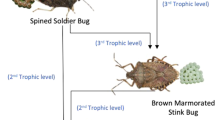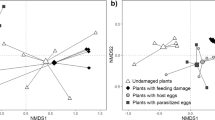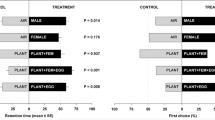Abstract
In response to insect herbivory, plants emit volatile organic compounds which may act as indirect plant defenses by attracting natural enemies of the attacking herbivore. In nature, plants are often attacked by multiple herbivores, but the majority of studies which have investigated indirect plant defenses to date have focused on the recruitment of different parasitoid species in a single-herbivore context. Here, we report our investigation on the attraction of egg parasitoids of lepidopteran hosts (Trichogramma brassicae and T. evanescens) toward plant volatiles induced by different insect herbivores in olfactometer bioassays. We used a system consisting of a native crucifer, Brassica nigra, two naturally associated herbivores [the butterfly Pieris brassicae (eggs and caterpillars) and the aphid Brevicoryne brassicae] and an alien invasive herbivore (eggs and caterpillars of the moth Spodoptera exigua). We found that Trichogramma wasps were attracted by volatiles induced in the plants by P. brassicae eggs, but not by those induced in the plants by S. exigua eggs, indicating the specificity of the plant responses toward lepidopteran herbivores. The results of the chemical analysis revealed significant differences between the volatile blends emitted by plants in response to attack by P. brassicae and S. exigua eggs which were in agreement with the behavioural observations. We investigated the attraction of Trichogramma wasps toward P. brassicae egg-induced volatiles in plants simultaneously attacked by larvae and nymphs of different non-hosts. The two chewing caterpillars P. brassicae and S. exigua, but not the phloem-feeding aphid B. brassicae, can disrupt the attraction of Trichogramma species toward P. brassicae egg-induced volatiles. Indirect plant defenses are discussed in the context of multiple herbivory by evaluating the importance of origin, dietary specialization and feeding guild of different attackers on the recruitment of egg-killing parasitoids.





Similar content being viewed by others
References
Agrawal AA (2007) Macroevolution of plant defense strategies. Trends Ecol Evol 22:103–109
Arimura G, Kost C, Boland W (2005) Herbivore-induced, indirect plant defences. Biochim Biophys Acta 1734:91–111
Bruce TJA, Wadhams LJ, Woodcock CM (2005) Insect host location: a volatile situation. Trends Plant Sci 10:269–274
Bruce TJ, Midega CA, Birkett MA, Pickett JA, Khan ZR (2010) Is quality more important than quantity? Insect behavioural responses to changes in a volatile blend after stemborer oviposition on an African grass. Biol Lett 6:314–317
Bukovinszky T, Poelman EH, Kamp A, Hemerik L, Prekatsakis G, Dicke M (2012) Plants under multiple herbivory: consequences for parasitoid search behavior and foraging efficiency. Anim Behav 83:501–509
Commonwealth Agricultural Bureau (CAB) (1972) Distribution maps of pests. Commonwealth Agricultural Bureau, London
Chabaane Y, Laplanche D, Turlings TCJ, Desurmont GA (2015) Impact of exotic insect herbivores on native tritrophic interactions: a case study of the African cotton leafworm, Spodoptera littoralis and insects associated with the field mustard Brassica rapa. J Ecol 103:109–117
Clavijo McCormick A, Unsicker SB, Gershenzon J (2012) The specificity of herbivore-induced plant volatiles in attracting herbivore enemies. Trends Plant Sci 17:303–310
Colazza S, Fucarino A, Peri E, Salerno G, Conti E, Bin F (2004) Insect oviposition induces volatile emission in herbaceous plants that attracts egg parasitoids. J Exp Biol 207:47–53
De Boer JG, Posthumus MA, Dicke M (2004) Identification of volatiles that are used in discrimination between plants infested with prey or nonprey herbivores by a predatory mite. J Chem Ecol 30:2215–2230
de Boer JG, Hordijk CA, Posthumus MA, Dicke M (2008) Prey and non-prey arthropods sharing a host plant: effects on induced volatile emission and predator attraction. J Chem Ecol 34:281–290
de Rijk M, Dicke M, Poelman EH (2013) Foraging behavior by parasitoids in multiherbivore communities. Anim Behav 85:1517–1528
De Vos M, Van Oosten V, Van Poecke R, Van Pelt J, Pozo M, Mueller M, Buchala AJ, Métraux JP, Van Loon LC, Dicke M, Pieterse C (2005) Signal signature and transcriptome changes of Arabidopsis during pathogen and insect attack. Mol Plant Microbe Interact 18:923–937
Desurmont GA, Harvey J, van Dam NM, Cristescu SM, Schiestl FP, Cozzolino S, Anderson P, Larsson MC, Kindlmann P, Danner H, Turlings TCJ (2014) Alien interference: disruption of infochemical networks by invasive insect herbivores. Plant Cell Environ 37:1854–1865
Dicke M (2009) Behavioural and community ecology of plants that cry for help. Plant Cell Environ 32:654–665
Dicke M, Baldwin IT (2010) The evolutionary context for herbivore-induced plant volatiles: beyond the ‘cry for help’. Trends Plant Sci 15:167–175
Dicke M, van Loon JJA, Soler R (2009) Chemical complexity of volatiles from plants induced by multiple attack. Nat Chem Biol 5:317–324
Erb M, Foresti N, Turlings TCJ (2010) A tritrophic signal that attracts parasitoids to host-damaged plants withstands disruption by non-host herbivores. BMC Plant Biol 10:247
Fatouros NE, Bukovinszkine’kiss G, Kalkers LA, Soler Gamborena R, Dicke M, Hilker M (2005) Oviposition-induced plant cues: do they arrest Trichogramma wasps during host location? Entomologia Experimentalis et Applicata 115:207–215
Fatouros NE, Bukovinszkine’Kiss G, Dicke M, Hilker M (2007) The response specificity of Trichogramma egg parasitoids towards infochemicals during host location. J Insect Behav 20:53–65
Fatouros NE, Lucas-Barbosa D, Weldegergis BT, Pashalidou FG, van Loon JJA, Dicke M, Harvey JA, Gols R, Huigens ME (2012) Plant volatiles induced by herbivore egg deposition affect insects of different trophic levels. PLoS ONE 7:e43607
Fatouros NE, Pineda A, Huigens ME, Broekgaarden C, Shimwela MM, Figueroa IA, Verbaarschot P, Bukovinszky T (2014) Synergistic effects of direct and indirect defences on herbivore egg survival in a wild crucifer. Proc R Soc B Biol Sci 281:1254
Giordanengo P, Brunissen L, Rusterucci C, Vincent C, van Bel A, Dinant S, Girousse C, Faucher M, Bonnemain JL (2010) Compatible plant–aphid interactions: how aphids manipulate plant responses. C R Biol 333:516–523
Hilker M, Fatouros NE (2015) Plant responses to insect egg deposition. Annu Rev Entomol 60:493–515
Hilker M, Kobs C, Varama M, Schrank K (2002) Insect egg deposition induces Pinus sylvestris to attract egg parasitoids. J Exp Biol 205:455–461
Hoedjes KM, Kruidhof HM, Huigens ME, Dicke M, Vet LEM, Smid HM (2011) Natural variation in learning rate and memory dynamics in parasitoid wasps: opportunities for converging ecology and neuroscience. Proc R Soc B Biol Sci 278:889–897
Kessler A, Heil M (2011) The multiple faces of indirect defences and their agents of natural selection. Funct Ecol 25:348–357
Meiners T, Hilker M (2000) Induction of plant synomones by oviposition of a phytophagous insect. J Chem Ecol 26:221–232
Moujahed R, Frati F, Cusumano A, Salerno G, Conti E, Peri E, Colazza S (2014) Egg parasitoid attraction toward induced plant volatiles is disrupted by a non-host herbivore attacking above or belowground plant organs. Front Plant Sci 5:601. doi:10.3389/fpls.2014.00601
Mumm R, Dicke M (2010) Variation in natural plant products and the attraction of bodyguards involved in indirect plant defense. Can J Zool 88:628–667
Mumm R, Tiemann T, Varama M, Hilker M (2005) Choosy egg parasitoids: specificity of oviposition-induced pine volatiles exploited by an egg parasitoid of pine sawflies. Entomol Exp Appl 115:217–225
Pashalidou FG, Huigens ME, Dicke M, Fatouros NE (2010) The use of oviposition-induced plant cues by Trichogramma egg parasitoids. Ecol Entomol 35:748–753
Peñaflor MFGV, Erb M, Miranda LA, Werneburg AG, Bento JMS (2011) Herbivore-induced plant volatiles can serve as host location cues for a generalist and a specialist egg parasitoid. J Chem Ecol 37:1304–1313
Pieterse CMJ, Leon-Reyes A, van der Ent S, van Wees SCM (2009) Networking by small-molecule hormones in plant immunity. Nat Chem Biol 5:308–316
Pieterse CMJ, van der Does D, Zamioudis C, Leon-Reyes A, van Wees SCM (2012) Hormonal modulation of plant immunity. Annu Rev Cell Dev Biol 28:489–521
Pilson D (1996) Two herbivores and constraints on selection for resistance in Brassica rapa. Evolution 50:1492–1500
Poelman EH, Dicke M (2014) Plant-mediated interactions among insects within a community ecological perspective. In: Voelckel C, Jander G (eds) Annual plant reviews insect plant interactions, vol 47. Wiley, New York, pp 309–338
Polaszek A (2010) Species diversity and host associations of Trichogramma in Eurasia. In: Consoli FL, Parra P, Zucchi RA (eds) Egg parasitoids in agroecosystems with emphasis on Trichogramma. Springer, Berlin, pp 237–266
Ponzio C, Gols R, Weldegergis BT, Dicke M (2014) Caterpillar-induced plant volatiles remain a reliable signal for foraging wasps during dual attack with a plant pathogen or non-host insect herbivore. Plant Cell Environ 37:1924–1938
R Development Core Team (2013) R: a language and environment forstatistical computing. R Foundation for Statistical Computing, Vienna. Available at: http://www.R-project.org/
Rasmann S, Turlings TCJ (2007) Simultaneous feeding by aboveground and belowground herbivores attenuates plant-mediated attraction of their respective natural enemies. Ecol Lett 10:926–936
Reymond P (2013) Perception, signaling and molecular basis of oviposition-mediated plant responses. Planta 238:247–258
Schoonhoven LM, van Loon JJA, Dicke M (2005) Insect–plant biology, 2nd edn. Oxford University Press, Oxford
Shiojiri K, Takabayashi J, Yano S, Takafuji A (2001) Infochemically mediated tritrophic interactions webs on cabbage plants. Popul Ecol 43:23–29
Soler R, Harvey JA, Bezemer TM, Kamp AFD, Vet LEM, van der Putten WH, Van Dam NV, Stuefer JF, Gols R, Hordijk CA, Bezemer TM (2007) Root herbivores influence the behavior of an aboveground parasitoid through changes in plant-volatile signals. Oikos 116:367–376
Sugio A, Dubreuil G, Giron D, Simon JC (2015) Plant-insect interactions under bacterial influence: ecological implications and underlying mechanisms. J Exp Bot 66:467–478
Tamiru A, Bruce TJA, Woodcock CM, Caulfield JC, Midega CAO, Ogol CKPO, Mayon P, Birkett MA, Pickett JA, Khan ZR (2011) Maize landraces recruit egg and larval parasitoids in response to egg deposition by a herbivore. Ecol Lett 14:1075–1083
Tamiru A, Khan ZR, Bruce TJA (2015) New directions for improving crop resistance to insects by breeding for egg induced defence. Curr Opin Insect Sci. doi:10.1016/j.cois.2015.02.011
Vickerman DB, Trumble JT (1999) Feeding preferences of Spodoptera exigua in response to form and concentration of selenium. Arch Insect Biochem Physiol 42:64–73
Waring P, Townsend M (2006) Nachtvlinders: veldgids met alle in Nederland en Belgiëvoorkomendesoorten (in Dutch). Tirion, Baarn
Wold S, Sjöström M, Eriksson L (2001) PLS-regression: a basic tool of chemometrics. Chemometr Intell Lab 58:109–130
Zhang PJ, Zheng SJ, van Loon JJA, Boland W, David A, Mumm R, Dicke M (2009) Whiteflies interfere with indirect plant defense against spider mites in Lima bean. Proc Natl Acad Sci USA 106:21202–21207
Zhang PJ, Broekgaarden C, Zheng SJ, Snoeren TAL, van Loon JJA, Gols R, Dicke M (2013) Jasmonate and ethylene signaling mediate whitefly-induced interference with indirect plant defense in Arabidopsis thaliana. New Phytol 197:1291–1299
Acknowledgments
The authors thank Andre Gidding, Joop Woelke and Frans van Aggelen for culturing insects and the experimental farm of Wageningen University (Unifarm) for rearing plants. This work, as part of the European Science Foundation EUROCORES Programme EuroVOL, was supported from funds by the Earth and Life Sciences Council of The Netherlands Organisation for Scientific Research (NWO/ALW Veni grant 863.09.002 to N.E.F.), by the National Research Council of Italy and by the German Research Foundation (CRC973).
Author information
Authors and Affiliations
Corresponding author
Additional information
Communicated by Caroline Müller.
Electronic supplementary material
Below is the link to the electronic supplementary material.
Rights and permissions
About this article
Cite this article
Cusumano, A., Weldegergis, B.T., Colazza, S. et al. Attraction of egg-killing parasitoids toward induced plant volatiles in a multi-herbivore context. Oecologia 179, 163–174 (2015). https://doi.org/10.1007/s00442-015-3325-3
Received:
Accepted:
Published:
Issue Date:
DOI: https://doi.org/10.1007/s00442-015-3325-3




